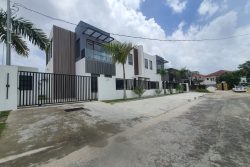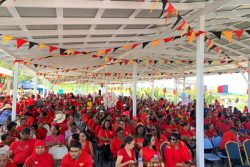With the advent of the oil economy, the annual budgets of this country will take on a distinctly different appearance. Deficit financing will begin to diminish and the big questions will become how much money from oil revenues should be injected into the economy and what size of budget can the country handle? Should there be any borrowing at all and should the external debt be immediately repaid? With a bonanza of US$607.6m from profit oil thus far, Wednesday’s budget presented by Senior Minister in the Office of the President with responsibility for Finance, Dr Ashni Singh was pegged at $552.9b, a whopping 44.3% larger than in 2021 in just the first year of the expenditure of oil revenues. A similar amount of oil revenue, based on the dubious formula outlined in the government’s Natural Resource Fund Act will likely be injected into the economy next year and this figure will rise progressively as the number of oil platforms increases to four. What are the monetary and other implications of the injection of US$607.6m into the economy and banking system in one fell swoop? The budget was silent on this.
The government has not been shy, however, of boasting about the expansion of the budget though it is worth noting again that it has been providentially gifted with access to extraordinary revenues due to ExxonMobil’s oil discoveries and not as a result of any deft reshaping of the economy which just before the first major find in 2015 was in the doldrums and tottering under the same Minister who presented Wednesday’s budget.
What the government now has to demonstrate is that it is capable of managing a budget of $552.9b – or even higher with the likelihood of approaches to Parliament for supplementary financing – in the context of the well-known poor execution capacity in the country and the dearth of human resources. For the last three decades or more Guyana has not been able to competently absorb large amounts of aid and loans as its execution capacity in the public sector was gravely lacking. Whereas in the past this was the experience of multilateral financial agencies like the IDB and the World Bank, the government might perhaps feel that since it will be the orchestrator of the majority of the expenditure that the execution capacity will magically appear. It will be totally misguided if that is its thinking.
Projects have to be properly devised and executed. There should already have been an engineers’ bill in place to protect citizens from defective works that end up costing the country even more. One would have thought that in the context of the Local Content Act that the government would have sought immediately to establish the bona fides of engineers, contractors and others in the construction sector to limit the prospect of them losing out to competitors from the Caribbean and further afield who may have better credentials. There is no sign of this and there are already hints that the government is unmoved by the imperative that mega projects have to be properly conceptualised, designed and executed. The clearest example of this is the adamancy on the part of the Environmental Protection Agency that there is no need for an Environmental Impact Assessment (EIA) for the new bridge over the Demerara River despite the fact that the floating structure is to be replaced by a fixed four-lane high span one and that there will be myriad implications for the population in the vicinity, the environment and the river itself. Some $21.1b has been earmarked in this year’s budget for expenditure on the bridge, a sign that the government is anticipating rapid approval despite the valid outstanding concerns.
Similar concerns have been raised about government’s planned gas-to-shore-to-energy project particularly over the risks engendered in piping gas here, the undermining of climate change commitments and financial feasibility. The terms of an EIA for this project are yet to be made public but there is already a massive sum earmarked in this budget – $20.8b. Further, at a press conference he convened on Saturday, President Ali presented a full-throated defence of the project without evincing concern about the major risks entailed.
According to the Office of the President, he said: “No doubt, this is our greatest opportunity not only for energy security but for creating an energy platform that would bring the jobs of the future…imagine how many jobs will be created during and after construction of our hydro and natural gas energy facilities; imagine what a reduction of 50% in your electricity costs will do for you; imagine what our new shorelines will look like; imagine what our own agrochemical plant will do; imagine what our own fertiliser plant will do for the agriculture sector; imagine what our own LNG (Liquefied Natural Gas) plant will do. Well, my friends, 2022 brings that imagination to life – as the seeds are now planted to realise all of this.”
The country is yet to be presented with comprehensive studies justifying all of the declarations made as it pertains to this project and it is unclear how many of the jobs spoken of by the President will be allocated to Guyanese considering the shortage of skills and the reality that training for these specialised sectors will take time.
Another major concern about this budget is whether its allocations sufficiently take into account the need to immediately address extreme poverty. There are increases in public assistance and old age pension and a most unusual allotment of $5b which has been explained in the following manner: “Given the complexity of the factors driving price increases and the limited policy instruments available to mitigate these increases…the government intends to engage in further consultations with the communities most affected both on the coast and in the hinterland on possible interventions to help ease the impact on the most vulnerable in our society. To this end, we have allocated a sum of $5 billion to meet the cost of the interventions to be implemented following these consultations”.
This is an amorphous allocation and rife with potential for subjective interpretation and discriminatory distribution while not addressing the needs of those in dire situations. A framework is needed for mapping extreme poverty throughout the country and proactively seeking to ameliorate conditions without creating overweening dependence. There should also be a fund to provide relief to families who experience tragedies that leave them on the edge of existence. This government has provided such assistance on a case by case basis but it now needs a formal structure to accomplish this.
There is great potential in the 2022 budget for advancing the development of the county and its people and in equal measure the risk of pitfalls.









